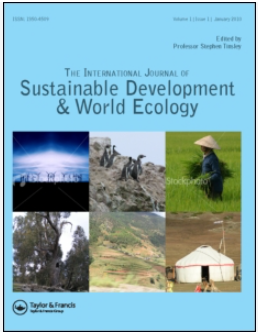Transhumant pastoralism in Indian western Himalaya: traditional ecological knowledge and contemporary practices
IF 7.7
3区 环境科学与生态学
Q1 ECOLOGY
International Journal of Sustainable Development and World Ecology
Pub Date : 2023-09-15
DOI:10.1080/13504509.2023.2254273
引用次数: 0
Abstract
ABSTRACTTranshumant pastoralism guided by traditional ecological knowledge (TEK) helps people in adapting to extreme biophysical conditions and remoteness in the high-altitude region of the western Himalaya. However, the age-old practice is currently under threat due to changes in socioeconomic, policy and environmental conditions, which may lead to erosion of pastoralism-related TEK. This study was undertaken to document traditional knowledge concerning transhumant pastoralism of the Kinnaura community in three high-altitude villages, namely Chhitkul, Rakchham and Batseri in the Kinnaur district of Himachal Pradesh, India, using semi-structured interviews and participant observation methods. A total of 38 key informants were interviewed to elicit information about the contemporary practices and TEK related to transhumant pastoralism. The study found that the transhumant pastoralism is not only intricately linked to sociocultural life but also contribute significantly to the livelihood of Kinnaura community and hired herders. Findings revealed that the pastoralists are the repository of vast knowledge on various aspects of sheep- and goat-based transhumance, viz. herd composition and management, grazing and supplementary feeding and ethnoveterinary practices. It is concluded that the study would help policy decisions for the preservation and protection of transhumant pastoralism-related TEK of the indigenous Kinnaura pastoralists. Further, considering the nexus between TEK and ecosystem services, this study would also contribute in well-being of the human society and resilience of the similar social-ecological systems.KEYWORDS: Kinnauralivestockpasturesethnoveterinary practiceLivelihoodssocial-ecological systems AcknowledgmentsThe authors are grateful to the informants and villagers of the study area for sharing valuable information and support during the field study. We express our deep gratitude to Professor K. G. Saxena and Dr. R. L. Semwal for the suggestions and guidance during the study. Financial assistance from the Department of Science and Technology, Government of India under the National Mission for Sustaining the Himalayan Ecosystem (NMSHE) to the Task Force entitled “Traditional Knowledge System- Network Programme on Convergence of Traditional Knowledge Systems for Integration to Sustainable Development in the Indian Himalayan Region” vide grant number DST/SPLICE/CCP/NMSHE/TF-5/JNU/2014[G] is thankfully acknowledged. We are thankful to the reviewers and the editor for comments and suggestions for improvement of the manuscript.Disclosure statementNo potential conflict of interest was reported by the author(s).Authors’ contributionSCG conceptualized the work, DKC conducted the fieldwork and both the authors analysed, interpreted and wrote the manuscript.Informed consentPrior informed consent was secured from the relevant local authority (District Magistrate, Kinnaur and Shimla) in accordance with National Biological Diversity Act (2002) and Rules (2004). Further, all informants gave verbal consent for the information they provided to be shared for academic purposes only.Additional informationFundingThis work was supported by the Department of Science and Technology, Government of India.印度西喜马拉雅地区的游牧:传统生态知识与当代实践
【摘要】在传统生态知识的指导下,在西喜马拉雅高海拔地区进行的跨牧活动有助于人们适应极端的生物物理条件和偏远的环境。然而,由于社会经济、政策和环境条件的变化,这一古老的做法目前正受到威胁,这可能导致与畜牧业有关的TEK受到侵蚀。本研究采用半结构化访谈和参与式观察的方法,在印度喜马偕尔邦金诺尔地区的三个高海拔村庄,即Chhitkul、Rakchham和Batseri,记录了有关金诺拉社区迁移畜牧业的传统知识。共采访了38名关键信息提供者,以了解与迁移畜牧业有关的当代实践和技术。研究发现,流动畜牧业不仅与社会文化生活有着错综复杂的联系,而且对Kinnaura社区和雇佣牧民的生计做出了重大贡献。调查结果显示,牧民拥有大量关于以绵羊和山羊为基础的跨放牧的各个方面的知识,即牧群组成和管理、放牧和补充喂养以及民族兽医做法。本研究将有助于Kinnaura土著牧民与迁移畜牧业相关的TEK的保存和保护政策的制定。此外,考虑到TEK与生态系统服务之间的联系,该研究也将有助于人类社会福祉和类似社会生态系统的恢复力。关键词:野生牲畜、牧场、民族兽医实践、生计、社会生态系统致谢致谢致谢致谢致谢致谢致谢致谢致谢致谢致谢致谢致谢致谢致谢致谢我们非常感谢K. G. Saxena教授和R. L. Semwal博士在研究过程中给予我们的建议和指导。感谢印度政府科技部根据维持喜马拉雅生态系统国家使命(NMSHE)向“传统知识系统——印度喜马拉雅地区传统知识系统融合促进可持续发展网络计划”工作组提供的财政援助(编号DST/SPLICE/CCP/NMSHE/TF-5/JNU/2014)。感谢审稿人和编辑对本文提出的改进意见和建议。披露声明作者未报告潜在的利益冲突。scg构思了工作,DKC进行了实地调查,两位作者都分析、解释和撰写了手稿。知情同意根据《国家生物多样性法》(2002年)和《规则》(2004年),事先获得了相关地方当局(金纳尔和西姆拉地区治安官)的知情同意。此外,所有举报人都口头同意他们提供的信息仅用于学术目的。本研究得到了印度政府科学技术部的支持。
本文章由计算机程序翻译,如有差异,请以英文原文为准。
求助全文
约1分钟内获得全文
求助全文
来源期刊
CiteScore
11.10
自引率
3.60%
发文量
58
审稿时长
18-36 weeks
期刊介绍:
The International Journal of Sustainable Development and World Ecology is now over fifteen years old and has proved to be an exciting forum for understanding and advancing our knowledge and implementation of sustainable development.
Sustainable development is now of primary importance as the key to future use and management of finite world resources. It recognises the need for development opportunities while maintaining a balance between these and the environment. As stated by the UN Bruntland Commission in 1987, sustainable development should "meet the needs of the present generation without compromising the ability of future generations to meet their own needs."

 求助内容:
求助内容: 应助结果提醒方式:
应助结果提醒方式:


